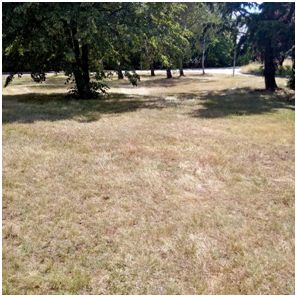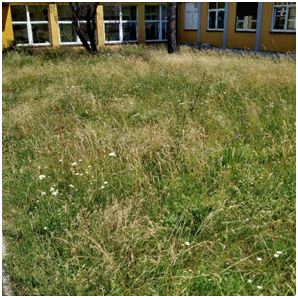Since the spring of 2019, we have been cooperating with the campus management to achieve more sustainable care of the lawns on our campus.
Description of the situation before 2019
- In the Krč campus of the Czech Academy of Sciences (CAS), a long-term contracted horticultural company maintains lawns and greenery.
- Until 2018, mowing took place approximately eight times a year from May to October, then several times raking leaves with mowers.
- When the short and often mowed lawn regularly dried up in the summer months (and the herbs didn’t even have a chance to bloom), this condition led us to write a call for more gentle lawn maintenance.
- We searched for new approaches to this problem and found that this issue is already relatively well worked out. Sustainable management of public greenery is already being tested in selected locations of specific cities (e.g. Žďár nad Sázavou or Hlinsko). Even the Environment Protection Department of Prague City Council issued methodical recommendations for the care of greenery.
- We first took the written proposal to the management of the Institute of Physiology, who supported us in this matter.
- Then, in cooperation with the campus administrator, we selected about half of our campus to be mowed only twice a year (before and after the summer holidays) while meeting other conditions – for example, mowing to a higher grass height. Therefore, the money saved for less frequent mowing can be used to improve the campus area (planting trees or building ponds).
- The campus council approved these proposals.
Practical results for 2019 and 2020
- In 2019 and 2020, we met with the campus management and the gardening company maintaining the lawns, and we agreed to limit grass cutting.
- Grass cutting on about half of the lawns was reduced to twice a year.
- Less frequently cut areas were more resistant to drought (they were visibly greener – we can see in the two photos from 3/7/2019, below), and plants bloomed on them, resulting in butterflies and other insects appearing. You can see photos from 2020 in this slideshow or in this album.
- This way, it was possible to transform a uniform lawn into a much richer and more beautiful growth, retaining moisture better. We are glad that at least part of the area has joined the current trend, which can be seen in various places (not only) in Prague. We attach a link to the topic of mapping the occurrence of butterflies in Prague, to which everyone can contribute.
- We also observed the grass snake, which is an endangered species.
- Almost no plants bloomed in the more frequently mowed areas (8 times a year).


Our plans
- We would like to promote the expansion of areas with less frequent mowing (only two mowing per year on the largest possible campus area, excluding “picnic” areas).
- Select areas where leaves would be raked only in the spring.
- Create a pile of cut branches in a suitable place to increase the diversity of the area’s habitat (insects, birds, hedgehogs).
- Build stone walls (insects, lizards) in suitable places.
- Build small bodies of water in suitable places – permanent or drying ponds (insects, amphibians, birds).
- Create a board at the campus entrance explaining why the lawn is not mowed, with a brief description of the sustainable management of the campus greenery.



